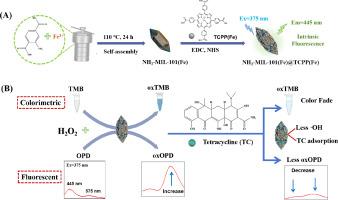基于金属卟啉共价修饰NH2-MIL-101(Fe)高效过氧化物酶样活性的比色/荧光双模生物传感器检测蜂蜜样品中的四环素
IF 9.8
1区 农林科学
Q1 CHEMISTRY, APPLIED
引用次数: 0
摘要
准确检测四环素残留对保证产品质量和保护人体健康具有重要意义。本文采用金属卟啉[TCPP(Fe)]共价修饰NH2-MIL-101(Fe)[命名为NH2-MIL-101(Fe)@TCPP(Fe)],研制了一种比色/荧光双模生物传感器,用于检测蜂蜜中四环素的含量。对该杂交纳米酶的形态、化学结构和过氧化物样活性进行了全面研究。基于NH2-MIL-101(Fe)@TCPP(Fe)优异的催化活性和固有荧光特性,研制了一种检测四环素的比色/荧光双模生物传感器。该双模式生物传感器的主要机制是四环素对NH2-MIL-101(Fe)@TCPP(Fe)催化的H2O2与3,3 ',5,5 ' -四甲基联苯胺(TMB)/邻苯二胺(OPD)之间的着色反应有抑制作用,这归因于四环素对·OH的消耗和四环素在NH2-MIL-101(Fe)@TCPP(Fe)表面的吸附。经有效验证后,将该比色/荧光双模式方法应用于三种实际蜂蜜样品中四环素残留的检测。本文章由计算机程序翻译,如有差异,请以英文原文为准。


Colorimetric/fluorescent dual-mode biosensor based on metalloporphyrin covalently modified NH2-MIL-101(Fe) with highly efficient peroxidase-like activity for the detection of tetracycline in honey samples
Accurate detection of tetracycline residue is of great significance for ensuring product quality and protecting human health. Here, a colorimetric/fluorescent dual-mode biosensor was developed for the detection of tetracycline in honey by using metalloporphyrin [TCPP(Fe)] covalently modified NH2-MIL-101(Fe) [named NH2-MIL-101(Fe)@TCPP(Fe)]. The morphology, chemical structure and peroxidas-like activity of this hybrid nanozyme were comprehensively studied. Based on excellent catalytic activity and intrinsic fluorescence of NH2-MIL-101(Fe)@TCPP(Fe), a colorimetric/fluorescent dual-mode biosensor was developed for the detection of tetracycline. The primary mechanism for this dual mode biosensor was the inhibitory effect of tetracycline on on NH2-MIL-101(Fe)@TCPP(Fe) catalyzed chromatic reaction between H2O2 and 3,3′,5,5′-tetramethylbenzidine (TMB)/o-phenylenediamine (OPD), which was ascribed to the consumption of ·OH by tetracycline and the adsorption of tetracycline on the surface of NH2-MIL-101(Fe)@TCPP(Fe). After effective validation, this colorimetric/fluorescent dual mode method was applied to detect tetracycline residues in three actual honey samples.
求助全文
通过发布文献求助,成功后即可免费获取论文全文。
去求助
来源期刊

Food Chemistry
工程技术-食品科技
CiteScore
16.30
自引率
10.20%
发文量
3130
审稿时长
122 days
期刊介绍:
Food Chemistry publishes original research papers dealing with the advancement of the chemistry and biochemistry of foods or the analytical methods/ approach used. All papers should focus on the novelty of the research carried out.
 求助内容:
求助内容: 应助结果提醒方式:
应助结果提醒方式:


